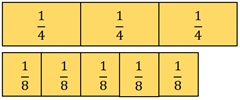Purpose
The purpose of this activity is to support students understanding that non-unit fractions are counts of unit fractions. For example, 3/4 = 1/4 + 1/4 + 1/4, meaning that three quarters is three counts of one quarter.
Achievement Objectives
NA3-1: Use a range of additive and simple multiplicative strategies with whole numbers, fractions, decimals, and percentages.
NA3-5: Know fractions and percentages in everyday use.
Required Resource Materials
- Unit fraction pieces, such as those created from Material Master 7-7.
Activity
- Draw, and have students draw, a number line with ends labelled 0 and 1. Alternatively, you might provide students with a number line.
Explore counting with unit fraction pieces by building up counts of one quarter, beyond one whole, on the number line. Mark the endpoints of each fraction strip using fraction symbols. Practise saying the sequence in words, “one quarter, two quarters, three quarters, four quarters, five quarters, …”.
You might introduce te reo Māori kupu related to fractions, such as haurua (halves), hautoru (thirds), hauwhā (quarters), and haurima (fifths).

- Draw attention to the numbers that are equivalent.
How many quarters equal one? How do we write a fraction for four quarters (4/4)
How many quarters equal one half? (2/4)
Can you give another name for six quarters? (1½).
- Use counting strategies to build up counts of thirds and fifths as non-unit fractions. Connect the words, symbols, and locations on the number line when iterating (creating repeated copies) of thirds and fifths.
.

- Pose comparison situations in which students compare the size of non-unit fractions. Look for students to generalise non-unit fractions as counts (iterations) of unit fractions, and for them to iterate the appropriate unit fraction lengths to create non-unit fractions.
- Which fraction is larger, 3/4 or 5/8?

- Which fraction is larger, 2/3 or 3/5?
- Which fraction is larger, 7/10 or 3/4?
- Which fraction is larger, 3/4 or 5/8?
Next steps
- Expect students to draw number lines and locate non-unit fractions with different denominators. Look to see that they apply the measurement principles of equal partitioning and iteration (putting units end-on-end). For example, ask students to create a number line for the fractions 1/2, 2/3, 3/4, 4/5, and 5/6.
- Check to see that those fractions are located correctly in relation to one. Halves, quarters, and eighths are suited to equal partitioning. Sixths can also be created by equal partitioning, cutting thirds in half or halves in thirds. Other fractions, especially thirds and fifths, suit checking by iteration of the unit fraction to see it fits the correct number of times in one.
- Look for students to notice patterns in the size of fractions they locate. For example, in locating 1/2, 2/3, 3/4, 4/5, and 5/6 they might notice that the fractions get closer to one. That can be explained by the part needed to make them equal to one gets smaller. 5/6 needs 1/6 to equal one while 4/5 needs 1/5 to be equal to one.
Add to plan
Level Three